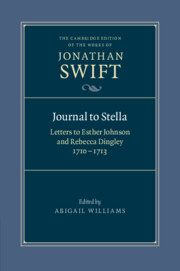Book contents
- Frontmatter
- Contents
- List of Illustrations Page
- General Editors’ Preface
- Acknowledgements
- Chronology
- List of Abbreviations
- Introduction
- Calendar of Letters
- Letters to Esther Johnson and Rebecca Dingley, 1710–1713
- Appendices
- A Swift, Harley, St John and the Political Debates Behind the Journal to Stella
- B Surviving Letters to and From Esther Johnson and Rebecca Dingley
- C Letter 2 in Print and Manuscript
- D Facsimile of Letter From Esther Johnson and Rebecca Dingley to Robert Dingley
- E Glossary of Little Language Used in the Journal to Stella
- F Biographical Appendix
- Textual Account
- Bibliography
- Index
Textual Account
Published online by Cambridge University Press: 02 September 2021
- Frontmatter
- Contents
- List of Illustrations Page
- General Editors’ Preface
- Acknowledgements
- Chronology
- List of Abbreviations
- Introduction
- Calendar of Letters
- Letters to Esther Johnson and Rebecca Dingley, 1710–1713
- Appendices
- A Swift, Harley, St John and the Political Debates Behind the Journal to Stella
- B Surviving Letters to and From Esther Johnson and Rebecca Dingley
- C Letter 2 in Print and Manuscript
- D Facsimile of Letter From Esther Johnson and Rebecca Dingley to Robert Dingley
- E Glossary of Little Language Used in the Journal to Stella
- F Biographical Appendix
- Textual Account
- Bibliography
- Index
Summary
Textual Introduction
The history of the Journal to Stella is given in the Introduction (pp. lxxi– lxxxiv) and the decisions informing this edition are also laid out there (pp. lxxxv–lxxxvii). This introduction provides additional bibliographical information underlying those decisions.
Choice of copy text
Deane Swift Letters (3–40)
The copy text for Letters 3–40 is the large octavo issue of Deane Swift's 1768 transcriptions of the letters: Letters, Written by the Late Jonathan Swift, D.D … Collected and Revised by Deane Swift, London, 1768 (ESTC T140271). John Hawkesworth had published three volumes of letters in 1766, XVIII–XX of his edition of the octavo Works (TS 88), and Deane Swift added three further volumes (XXI–XXIII of the Works), of which the first two, Letters vols. IV and V, contained material later to become part of the Journal. These volumes are listed as 1768a below. At the same time the letters were issued in the quarto Works (TS 87) as additions to Hawkesworth's two volumes (Works X–XI), forming Letters vols. III and IV (Works XII–XIII), of which vol. III contained the Journal material (ESTC T38576). This volume is listed as 1768b below.
This edition chooses the octavo as copy text because the octavo and quarto volumes of letters are not separate editions, but separate issues, using the same type but differently imposed, and the octavo was possibly imposed first. The absence of headlines (except for page numbers) was designed to simplify reimposition, but, as the measure of the quarto is much longer than that of the octavo, major rearrangement of type was necessary. There is some evidence from the Bowyer printing ledgers that in these circumstances printers set the octavo first. The Bowyers did not print these volumes but they were responsible for earlier volumes in the series. The entry for the Works octavo volumes for 23 December 1754 says ‘overrun into quarto’, and Maslen and Lancaster explain that ‘overrunning … may result from a decision to widen the type page when an 8o issue is to be followed by a 4o’.
- Type
- Chapter
- Information
- Journal to StellaLetters to Esther Johnson and Rebecca Dingley, 1710–1713, pp. 697 - 734Publisher: Cambridge University PressPrint publication year: 2013



